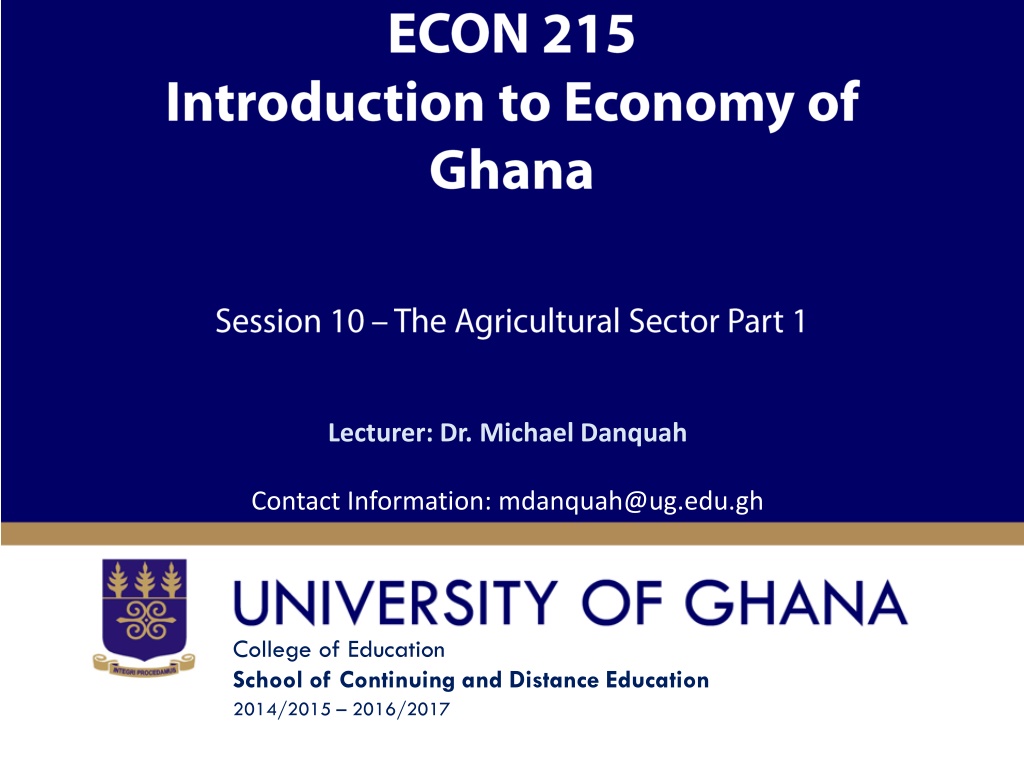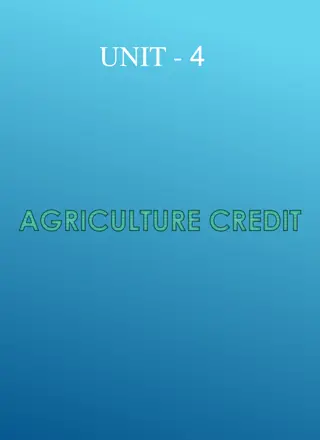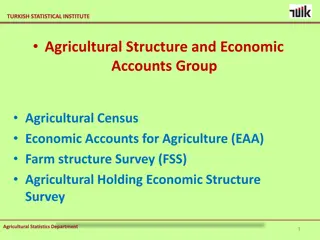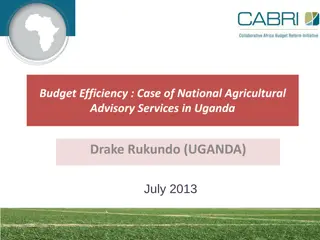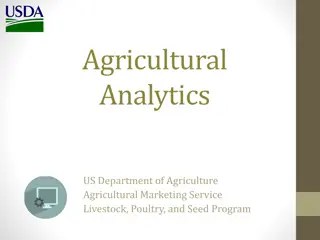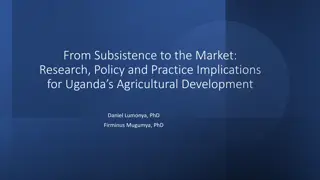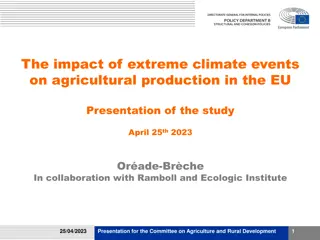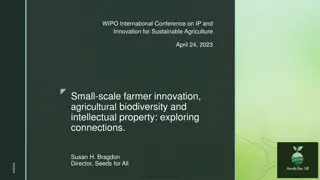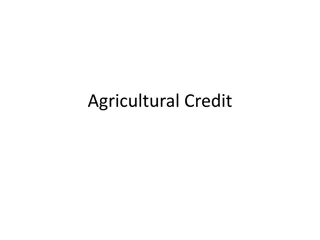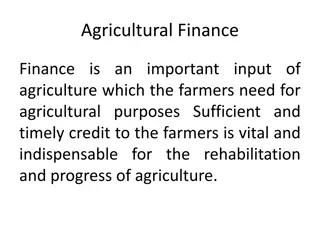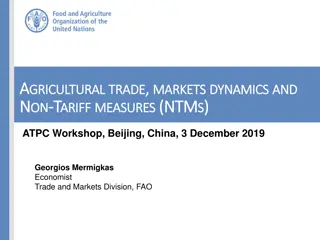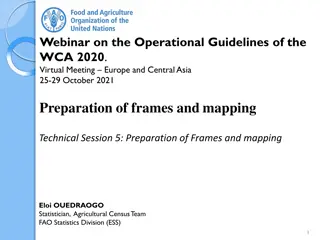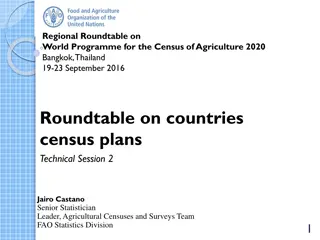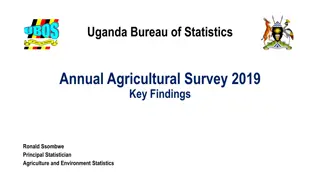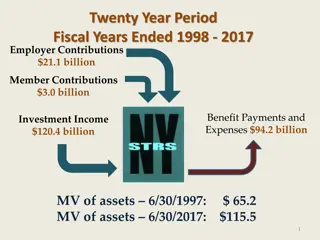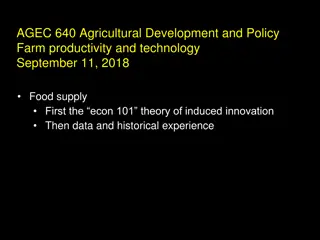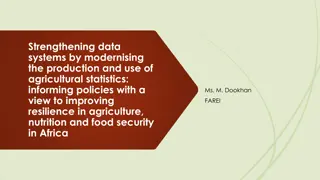Understanding Ghana's Agricultural Sector: Key Features and Contributions
Explore the structure and nature of Ghana's agricultural sector through topics like cocoa production, crops, livestock, forestry, and fisheries. Discover the key roles agriculture plays in Ghana's economy, and the performance of its sub-sectors. Gain insights into the different types of agricultural systems in Ghana, from small-scale subsistent to large-scale mechanized operations.
Download Presentation

Please find below an Image/Link to download the presentation.
The content on the website is provided AS IS for your information and personal use only. It may not be sold, licensed, or shared on other websites without obtaining consent from the author. Download presentation by click this link. If you encounter any issues during the download, it is possible that the publisher has removed the file from their server.
E N D
Presentation Transcript
Lecturer: Dr. Michael Danquah Contact Information: mdanquah@ug.edu.gh College of Education School of Continuing and Distance Education 2014/2015 2016/2017
Session Overview Session Overview: Until recently, Ghana had been known to be an agrarian economy since it contributed significantly to the Gross Domestic Product (GDP), the employment levels and economic growth of Ghana. This session discusses the main features of the agricultural sector as well as the benefits of sector to national economy. Goals/ Objectives: At the end of the session, the student will Know the components of the agricultural sector in Ghana Appreciate the contribution of the sector to Ghana s economy Know the performance of the sub-sectors of agriculture in Ghana Slide 2
Session Outline The key topics to be covered in the session are as follows: Topic One: The Structure and Nature of the Agricultural Sector in Ghana Topic Two: Role of Agriculture in the Ghanaian Economy Topic Three: Performance of the Agricultural Sector in Ghana Slide 3
Reading List Refer students to relevant text/chapter or reading materials you will make available on Sakai Slide 4
Topic One THE STRUCTURE AND NATURE OF THE AGRICULTURAL SECTOR IN GHANA Slide 5
Structure of the Agricultural Sector in Ghana The agricultural sector in Ghana is divided into 4 broad sub- sectors: THE COCOA SUB-SECTOR: The production of cocoa beans, paste and butter THE CROPS AND LIVESTOCK SUB-SECTOR: Crops such as cereals, starchy stable, pulses and nuts, vegetables and all other crops apart from cocoa Slide 6
Structure of the Agricultural Sector in Ghana Cont d THE FORESTRY AND LOGGING SUB-SECTOR: All activities associated with the production of timber logs and sawn timber THE FISHERIES SUB-SECTOR: The production of fish and fish products such as tilapia, lobsters, tuna, etc Slide 7
Nature of Agriculture in Ghana There are two types of agriculture systems in Ghana: The subsistent small-scale: This is the dominant system in Ghana The mechanised large scale: The focus of this system is on production for sale. Slide 8
Nature of Agriculture in Ghana Contd The Ghanaian agriculture is characterized by the following: Rainfall is the main determinant of cultivation and irrigation farming is minimal Heavy Dependence on Rainfall: Small-scale farmers use simple tools like hoes and cutlass and farming activities are highly labour intensive. While large scale producers use tractors and harvesters. Use of Low Level Technology: Use of modern inputs such as fertilisers and pesticides, and mechanisation are not widespread. Land Preparation is done by slashing and burning of vegetation. Also, the farming system mainly depends on the natural soil fertility Predominant Use of Traditional Farming Methods: Slide 9
Nature of Agriculture in Ghana Contd Dominance of Small-Scale Production Enterprises: The sector is made up of several thousands of small-scale farmers who cultivate land sizes less than 5 hectares. The few large scale producers have plantations of over 100 hectares. The bulk of the agricultural output is produced by the small-scale farmers. Low Financing: Loans from financial institutions are very low due to either they are unavailable or farmers cannot meet requirements needed to access credit from the banks. Slide 10
Topic Two ROLE OF AGRICULTURE IN THE GHANAIAN ECONOMY Slide 11
SECTORS CONTRIBUTION TO GDP In the 1970s and 1980s the sector contributed an average of 55% to GDP but declined to an average of 42% in the 1990s. Between 2009 and 2014, it averaged 25.6% of GDP recording the least share of GDP in 2011 (25.3%), 2012 (22.9%), 2013 (22.4%) and 2014 (21.5%). The decline is mainly due to the growing influence of the services sector. Slide 12
SECTORS CONTRIBUTION TO FOREIGN EXCHANGE EARNINGS The sector contributes substantially to foreign exchange earnings as a result of export of mainly cocoa and timber, and non-traditional exports of other crops. For instance, the agric sector exports contribute 76.2% of total export earning in 1986 but its contribution has been decreasing over the years to 35.7% in 2000, 38% in 2008 and 25.5% in 2011. Similarly, in 2011 the cocoa sub-sector alone earned Ghana $2.871billion compared to 2.285billion in 2010 Slide 13
SECTORS CONTRIBUTION TO GOVERNMENT REVENUE AND FOOD SUPPLY GOVERNMENT REVENUE Government gets revenue from agric tax and duties on cocoa in the agric sector. From 12.2% in 1990, the agric sector contribution to tax revenue declined consistently to 4.1% in 2000 and rose again to 5% in 2008. FOOD SUPPLY Agric produces food items to meet the nutritional and healthy living needs of the population. This helps ensure that a healthy nation is a wealthy nation. However, due to taste and preferences some citizens prefer imported food items compared to locally produced ones especially in urban areas. Slide 14 But this has not diminished the sectors contribution as high
RAW MATERIALS FOR INDUSTRIES Ideally, the agric sector is supposed to provide linkage with the industrial sector to facilitate value addition and manufacturing. However, due to its problems the sector is unable to perform this role effectively but we do have some of our textile factories depend on local cotton and agric products are serving as raw materials for local industries which produce soap products. and pharmaceutical/herbal Slide 15
SECTORS CONTRIBUTION TO EMPLOYMENT Though the share of agric in GDP has been on the decline over the years, the sector still contributes more to employment generation than any of the other sectors. At least, 50% of the economically active population is employed in the agric sector. For example, from a high of 64% employment generation in 1960, this has declined to 45% in 2000 and in 2008, it generated about 43.5% jobs compared to 37.3% from the services sector in 2008. Slide 16
Topic Three PERFORMANCE OF THE AGRICULTURAL SECTOR IN GHANA Slide 17
Overall Performance of the Agriculture Sector in Ghana The sector in the year under review saw a decline in the growth rates as compared to 2013 with an overall growth rate of 4.6%. There was a consistent increase in growth rate within the sector from 2011, when the agricultural growth rate rose from 0.8% to 2.3% in 2012 to 5.2% in 2013. The year s growth is accounted for by contributions of all the subsectors except fisheries sub-sector which witnessed a fall in growth from 5.7% in 2013 to -5.6% in 2014. Slide 18
Performance of Cocoa sub-sector Cocoa continues to be a major foreign exchange earner for Ghana s economy. In 2014 measures undertaken under the coco Hi-Tech Fertilizer Application and the Cocoa disease and Pests Control (CODAPEC) programmes, as well as the provision of operational inputs to ensure high productivity were continued. In spite of these interventions, production fell by 5.2% in 2014. Production dropped from approximately 945,000 tonnes in the 2012/13 cropping season to 896,000 tonnes in the 2013/14 season Slide 19
Performance of Food Crop sub-sector The production of roots and tubers increased with cassava recording the most increase in output 15.99 million metric tonnes to 16.524 million metric tonnes (MT) representing a 3.34% increase in output. Yams saw the least percentage change 0.62% showing an increase in output from 7.075 million metric tonnes to 7.119 million metric tonnes in 2014. Similarly, yams recorded the least increase in the total area cultivated in 2014 from 422 hectares to 428 hectares (1.42%). There was nonetheless a decline in yields in yams dropping from 16.78% in 2013 to 16.6% in 2014. Slide 20
Performance of Food crops sub-sector cont d In terms of cereals, there was a marginal drop in the output of maize from 1.765 million MT to 1.762 million MT. over the same period however, there were increases in the output of sorghum, and rice, with millet maintaining the same level in 2013. There was also increases in the are cultivated for sorghum, millet and rice by 0.44%, 0.62% and 4.17% respectively. Maize however saw a fall in the area cultivated from 1,024 hectares to 1,019 hectares in 2014. The drop in the area cultivated for maize corresponded with a drop in the yields by 1.16% for the year under review. A decline was also recorded for sorghum for 9.09% over the same period. There were increases, however, in yields for the remaining cereal products (Table 5.7), where millet and rice increased by 3.09 and 2.2.7% respectively. Slide 21
References Slide 22
